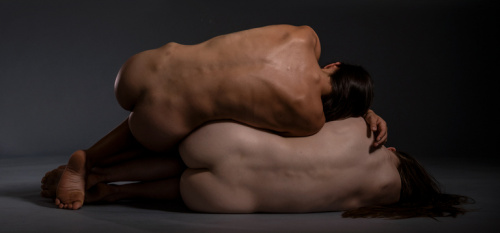PŌHUTU - Bianca Hsylop
6 June 2019, Hannah Playhouse, Wellington
Kia Mau Festival
Reviewed by Mona Williams

Pōhutu refers to the Southern Hemisphere’s largest active geyser, at Rotorua’s Whakarewarewa, a place of Mother Earth’s scalding, erupting water and violently bubbling mud pools. A duo of Bianca Hyslop and Rose Tapsell embodied this powerfully restless, shape-shifting, earth-anchored fault-line to traverse the life history of Bianca’s 88 year old grandmother. The work was visually engaging, like a feather-cloak, displaying ancient Māori symbolism in fluid, evocative floor rolls, changing levels, thought provoking spatial arrangements, small lifts and sculptural lines. This physically punishing choreography involving seemingly effortless floor movements, commanded our appreciation of the dancers’ skill and the Iwi’s voice, vision and power.
Opening the performance with Birth, that is, emerging ‘into the world of light’, with blinding, pulsating strobe lighting and heart-hammering sounds, the audience was thrust into a cosmos entirely drenched in noises; Rotorua’s gurgling streams, mōteatea, haka, bird thrills, karakia, thunder, screams, snatches of panicked voices, plucked strings, a children’s game in te reo Māori, young voices urging each other to jump off the bridge to dive for tourists’ thrown pennies, soothing rainfall and passages of smooth violin music. The dancers’ extended pas de deux interpreted and amplified the turbulent soundscape, employing sophisticated interweaving, thematic variations of body-line and synchronised earth bound partnering. The uncomplicated set-design, a stark stage holding two panels of transparent plastic sheets in an aluminium frame, suspended about eight feet off the ground, permitted rolling under, around and within this prop.
The grandmother’s marriage, motherhood, maturity and ageing coincided with social and political upheavals for Māori in Aotearoa. Projections of old whare, carved wooden ancestors, greenstone, crosses, undulating hills, marae and landforms sacred to the iwi melded with the duo’s disciplined adagio passages and gentler interpretations. These afforded the opportunity to see minutiae more acutely and to appreciate the dancers’ strong technique more critically. Then the surprise hit home; the female dancers give a perfect execution of the traditional male warriors’ dance with the taiaha, (fashioned from clear glassy-looking curtain rods) that symbolised changing female self-assurance, roles and competence. The mists of Rotorua swirled at ground level, enveloped and transformed this world of dance. Emma Ransley’s simple costumes in gossamer fabric had portrayed the bridal occasion and it also foreshadowed the ending of the life story.
Ultimately, an abrupt cut to a black stage, then red lights illumined a figure dressed in a red gossamer gown, who had the life shaken out of her, as if by electrocution. The hands shook in a farewell as powerful as a Rotorua earthquake. The grandmother offered no resistance. She had always been connected to Papatūānuku, Earth Mother, so, peacefully, the duo surrenders to life’s end as unclothed as they had been emerging from the womb. This mesmerising performance was unwavering in its Māori voice, perspective and integrity.
The applause erupted like a geyser.
